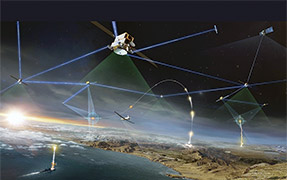Simultaneous sensing of ozone levels and gamma radiation in a hand-held device
With increased efforts to monitor health and safety, environmental sensors have been integrated into commercial applications, including home safety and building ventilation systems. Two important subjects for monitoring include ozone (O3) and gamma radiation. Ozone is a powerful oxidizing agent, widely used as a disinfectant and deodorizing agent,1 and emitted during the operation of electronic devices such as photocopiers and laser printers. Its deleterious effects on human health include respiratory inflammation and congestion, pulmonary edema, hemorrhage, and even death.
Measurements of ozone concentrations are typically carried out with analytical instruments based on photometric, chemiluminescence, and fluorescence techniques, including iodide methods, passive sampling, mass spectrometry, and remote monitoring. These techniques are accurate and sensitive, even for atmospheric concentrations, but they require expensive equipment and a high degree of operating expertise and data interpretation.3
Ionizing radiation from both natural and man-made sources can also affect the various organs and tissues of the body. Radiation processing is an expanding technology with numerous applications in many domains, including health care products sterilization, sewage and hospital waste treatment, polymer modification, and food processing. Moreover, real-time radiation detectors have become essential to emergency personnel when responding to accidents, environmental incidents, or terrorist attacks that may involve radioactive material.
To assess indoor air pollution due to physical, chemical, or microbiological agents, there exists a need for real-time environmental monitoring systems that record data from sensors of various types to provide a complex picture of environmental conditions. We have focused on developing ozone and radiation sensors, based on mixed-oxide films. Cost-effectiveness is a key requirement. Our devices rely on the underlying fact that radiation and ozone emissions cause defects in the materials and, consequently, change their properties. Such changes, manifest as alterations in both electrical and optical parameters, are under investigation for dosimetry and sensor development.
Thermally co-evaporated films of mixed oxides, such as indium (In2O3), zinc (ZnO), and tin (SnO2) are candidates for both gamma radiation and ozone sensing.3 This approach should allow a unique system to be designed that can simultaneously detect both gamma radiation and ozone levels. Such a system could be used for environmental or personnel protection monitoring, and to aid compliance with safety regulations. Thin-film sensors are generally thought to be the best choice for detecting strongly oxidizing gases because sensor properties and geometry can readily be manipulated. Ozone immediately interacts with the outermost layers of the sensor, producing a change in its electrical properties, such as conductance. As for gamma radiation, its effects on electrical properties of thin films can be estimated by measurements of conductance versus dose in real time (every 5s) using an impedance analyzer (HP 4277A LCZ-meter) at a frequency of 1kHz. Figure 1 shows the response of a 90nm In2O3:ZnO:SnO2 thin-film structure with Cu interdigitated electrodes to gamma radiation in dose range from 0 to 180mGy.

Because the same In2O3:ZnO:SnO2 thin-film devices are used for combined sensing, proper shielding is essential to distinguish between gamma and ozone detection. Moreover, a head in the form of sensor arrays with corresponding software could enhance overall performance and avoid misinterpretation of results due to cross-sensitivity.
Figure 2 illustrates the prototype of the hand-held device for interfacing resistance-based sensor arrays for real-time radiation and ozone monitoring. The system boasts a modular nose head design that accepts different arrays for configuration to specific tasks. Currently, the system can interface an array with up to eight sensors, with analog signals multiplexed en route to the analog-to-digital converter.
The device is also capable of storing acquired data for further analysis, and has built-in software for displaying it in real time. It can also execute classification of radiation types/doses and ozone levels using pattern recognition algorithms. Hybrid sensor arrays could be interfaced for a dual or multi-function device, becoming an electronic nose. For example, if one part of the sensor array was allocated for ozone monitoring, the other could consist of radiation sensors. Sensors that detect other toxic gases would facilitate use of the overall system for various personnel and security applications.4
This work was supported by the Irish Research Council for Science, Engineering and Technology (IRCSET), funded by the National Development Plan.
Khalil Arshak, a professor in the Electronics and Computer Engineering Department, University of Limerick lectures on microelectronics, solid-state electronics, VLSI technology, design for reliability and digital electronics, electronic properties of materials, nanolithography, and related subjects. He is the author or co-author of more than 350 research publications, including book chapters, and several patents.
Olga Korostynska received her BS and MS degrees in biomedical electronics from the National Technical University of Ukraine, Kyiv, in 1998 and 2000, and a doctorate from the University of Limerick in 2003, where she is currently a research fellow.
Ger Hickey received a bachelor's degree in electronic engineering from the Waterford Institute of Technology in 2004. In 2005, he joined the Microelectronics and Semiconductor Research Centre, at the University of Limerick. He has authored journal and conference publications, and his research interests include gas sensing technologies and thin-film resistive sensors for ozone detection.




